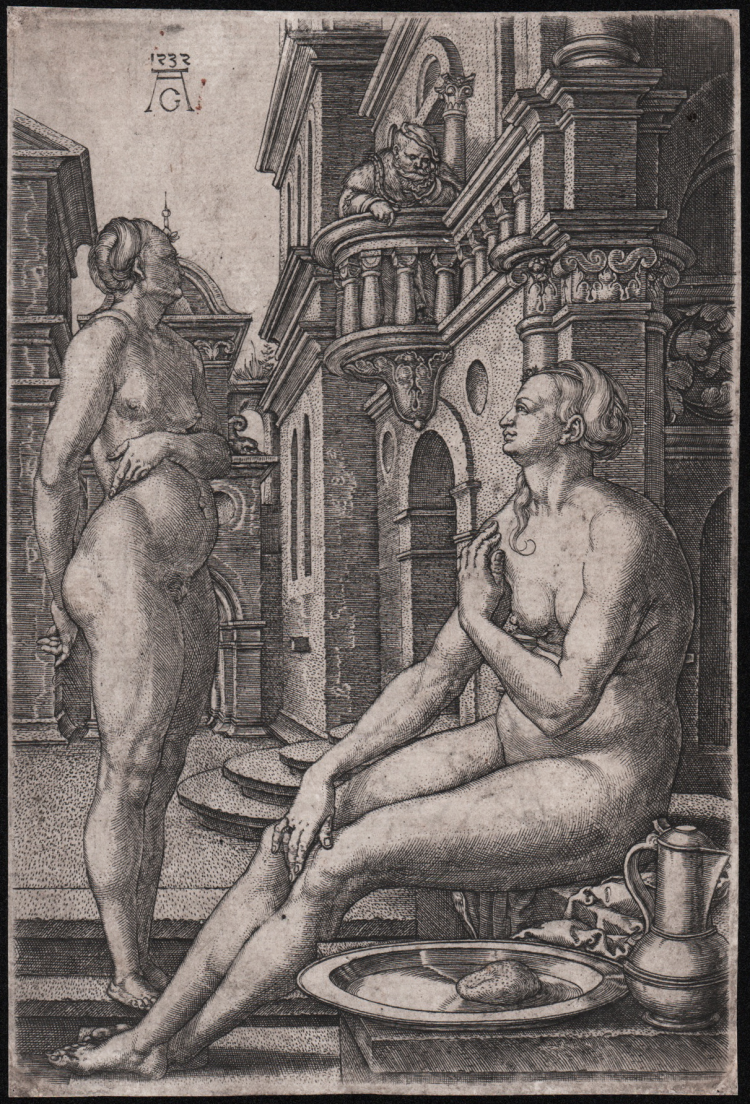



| Reference: | S44843 |
| Author | Heinrich ALDEGREVER |
| Year: | 1532 |
| Measures: | 100 x 150 mm |


| Reference: | S44843 |
| Author | Heinrich ALDEGREVER |
| Year: | 1532 |
| Measures: | 100 x 150 mm |
David and Bathsheba; Bathsheba at the bath, seated in right foreground; another nude female figure standing next to her in the court-yard at left; David looking on from a balcony of the building at right.
Engraving, 1532, signed with monogram and dated at upper left.
The story is told in the Bible, in the Second Book of Samuel. David, blessed King of Israel by the priest and prophet Samuel, while his soldiers are busy ravaging the land of the Ammonites and laying siege to a city, remaining in his palace in Jerusalem, from the terrace sees Bathsheba, the daughter of Eliam, bathing. David enchanted by her beauty and distraught with desire, though he knows that she is the wife of Uriah, one of his most valiant commanders, summons her and has carnal intercourse with her.
Shortly before 1520, some young artists in Albercht Dürer's circle took to making very small engravings that challenged the viewer with a miniature world of new secular subject matter and unconventional interpretations of traditional themes. Because of the small size of their engravings, these artists have long been affixed with the collective, and unflattering, name of Small Nuremberg Masters. The core of the group consists of three artists from Nuremberg, Hans Sebald & Bartel Beham and Georg Pencz, and in addition Jacob Bink from Cologne and Heinrich Aldegrever from Soest.
Example in the second state of three. Beautiful proof, printed on contemporary laid paper with "unicorn" watermark (similar to Piccard 3144, which dates it to 1535), with thin margins or trimmed to copper, minimal restorations to lower corner and upper left corner, otherwise in excellent condition.
Bibliografia
New Hollstein (German), The New Hollstein: German engravings, etchings and woodcuts 1400-1700 (37.II); Bartsch; Le Peintre graveur (VIII.373.37).
Heinrich ALDEGREVER (Paderborn, 1502; Soest, Westfalia, 1555–61)
|
German engraver, painter and designer. He was the most important graphic artist in Westphalia in the 16th century. His reputation rests largely on his ornamental designs, which make up about one third of his c. 300 engravings. They were principally intended as models for metalworkers but were also adapted by other craftsmen for such decorative arts as enamel, intarsia and book illustration. Aldegrever followed Dürer and the Nuremberg LITTLE MASTERS, deriving models for his paintings and subject prints as well as a full repertory of Renaissance ornamental motifs: fig and acanthus foliage, vases and cornucopia, combined with putti and satyrs, tritons, mermaids and dolphins, sphinxes, masks and medallions. From the beginning of his career Aldegrever was aware of the artistic trends of the time: the Dürer influence was strongest at its outset yielding somewhat in work of the 1530s to Mannerist tendencies under Netherlandish influence, though never waning entirely.
|
Heinrich ALDEGREVER (Paderborn, 1502; Soest, Westfalia, 1555–61)
|
German engraver, painter and designer. He was the most important graphic artist in Westphalia in the 16th century. His reputation rests largely on his ornamental designs, which make up about one third of his c. 300 engravings. They were principally intended as models for metalworkers but were also adapted by other craftsmen for such decorative arts as enamel, intarsia and book illustration. Aldegrever followed Dürer and the Nuremberg LITTLE MASTERS, deriving models for his paintings and subject prints as well as a full repertory of Renaissance ornamental motifs: fig and acanthus foliage, vases and cornucopia, combined with putti and satyrs, tritons, mermaids and dolphins, sphinxes, masks and medallions. From the beginning of his career Aldegrever was aware of the artistic trends of the time: the Dürer influence was strongest at its outset yielding somewhat in work of the 1530s to Mannerist tendencies under Netherlandish influence, though never waning entirely.
|